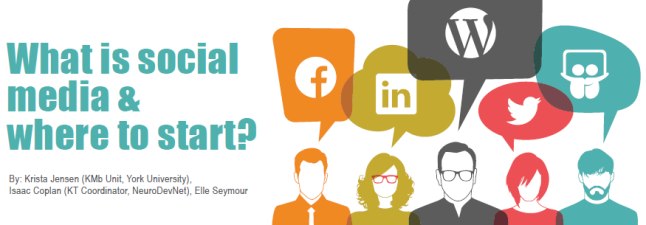Blog post by: Isaac Coplan, @neurodevnetkt
The KT Core has produced a new resource for NeuroDevNet researchers and trainees, referred to as the social media “guide of guides”. It is the newest addition to our collection of KT Tools that we feature on the NeuroDevNet Website. It is an annotated bibliography of the best and most applicable published guides for researchers to “do KT” for their research.
Starting to use social media for Knowledge Translation can be overwhelming, especially for busy researchers who are not familiar with social media and who might not see the value of it for dissemination and stakeholder engagement. Indeed, a simple Google search will result in a large number of articles, blogs and websites that promise to direct you on how to start. Many of them charge money for unnecessary programs or services related to social media– and few are directly related to KT. Before I began my position as KT Coordinator with NeuroDevNet, Krista Jensen (of the York University Knowledge Mobilization Unit) and Elle Seymour (former KT Coordinator, NeuroDevNet) had conducted a search and narrowed them down to the top guides. I was happy to help finalize the guide and organized them from guides targeted at the beginner level to more advanced levels.
Our “guide of guides” begins with a section that explains the value of social media for researchers, for KT purposes and organizes the guides reviewed into several other sections:
Planning & Strategic Social Media Guides
Advanced resources, metrics and tools for measuring social media reach
While social media is certainly transforming the way that information is viewed, communicated and shared it isn’t necessarily making these processes simple. Social media requires planning – and for more complex strategies, can require designated staff. If you are beginning to use social media – you may be curious about how it has helped researchers with KT. The first section “Why use social media?” provides links and useful annotations to a variety of resources. This can provide you with initial push to start thinking about social media and answer some of your questions about why researchers use different platforms. Another example of how this guide may be used, is if there is a researcher who connects with people online, but hasn’t started thinking about social media strategically. The “Planning & Strategic Social Media Guides” section has resources that will help you move from a casual social media user – to a more strategic user. The final section “Advanced resources, metrics and tools for measuring social media reach” looks at tools that can provide you with more advanced thinking on social media. The guides in this section cover topics such as tracking research, reach of your social media channels and data visualization.
Overall- there are many advantages to social media use by researchers – one of the overarching benefits is the number of people that are now using social media regularly, which means the number of stakeholders that can be reached in this way by researchers is also greater. These stakeholders include: researchers from institutions around the world, mainstream media, research networks, non-profit organizations, community organizations, health care institutions, government offices and education institutions from most of the world to name a few.
This guide is a good reference for researchers and trainees who want to start using social media for KT. If you are a researcher/trainee and already using social media, you can use the more advanced guides referenced in this “guide of guides” in order to approach social media more strategically. Social media doesn’t have to be mystical – these guides can help you.
If you are a NeuroDevNet researcher or trainee we can help you learn how to use social media for KT, or help you advance your existing strategy, contact the KT Core!


